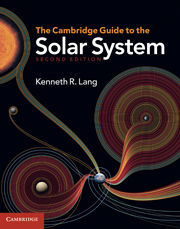Book contents
- Frontmatter
- Contents
- List of focus elements
- List of tables
- Preface to the second edition
- Preface to the first edition
- Principal units
- Part 1 Changing views and fundamental concepts
- 1 Evolving perspectives: a historical prologue
- 2 The new close-up view from space
- 3 Atmospheres, magnetospheres and the solar wind
- Part 2 The inner solar system: rocky worlds
- Part 3 The giant planets, their satellites and their rings: worlds of liquid, ice and gas
- Part 4 Remnants of creation: small worlds in the solar system
- Part 5 Origin of the solar system and extrasolar planets
- Author index
- Subject index
1 - Evolving perspectives: a historical prologue
from Part 1 - Changing views and fundamental concepts
Published online by Cambridge University Press: 05 August 2011
- Frontmatter
- Contents
- List of focus elements
- List of tables
- Preface to the second edition
- Preface to the first edition
- Principal units
- Part 1 Changing views and fundamental concepts
- 1 Evolving perspectives: a historical prologue
- 2 The new close-up view from space
- 3 Atmospheres, magnetospheres and the solar wind
- Part 2 The inner solar system: rocky worlds
- Part 3 The giant planets, their satellites and their rings: worlds of liquid, ice and gas
- Part 4 Remnants of creation: small worlds in the solar system
- Part 5 Origin of the solar system and extrasolar planets
- Author index
- Subject index
Summary
• The wandering planets move in a narrow track against the unchanging background stars, and some of these vagabonds can suddenly turn around, apparently moving in the opposite direction before continuing on their usual course.
• The ancient Greeks noticed that the Earth always casts a curved shadow on the Moon during a lunar eclipse, demonstrating that our planet is a sphere.
• For centuries, astronomers tried to describe the observed planetary motions using uniform, circular motions with the stationary Earth at the center and with the distant celestial sphere revolving about the Earth once a day.
• Around 145 AD, Claudius Ptolemy devised an intricate system of uniform motion around small and large circles to model the motions of the Sun, Moon and planets around a stationary Earth; his model was used to predict their location in the sky for more than a thousand years.
• The stars seem to be revolving around the Earth each night, but the Earth is instead spinning beneath the stars. This rotation also causes the Sun to move across the sky each day.
• Mikolaj Kopernik, better known as Nicolaus Copernicus, argued in 1543 that the Earth is just one of several planets that are whirling endlessly about the Sun, all moving in the same direction but at different distances from the Sun and with speeds that decrease with increasing distance. […]
- Type
- Chapter
- Information
- The Cambridge Guide to the Solar System , pp. 1 - 35Publisher: Cambridge University PressPrint publication year: 2011



